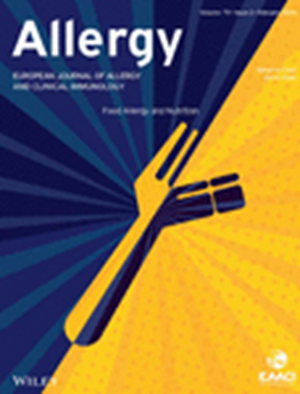How type-2 dendritic cells induce Th2 differentiation: Instruction, repression, or fostering T cell-T cell communication?
IF 12.6
1区 医学
Q1 ALLERGY
引用次数: 0
Abstract
Allergic disease is caused by the activation of allergen-specific CD4+ type-2 T follicular helper cells (Tfh2) and T helper 2 (Th2) effector cells that secrete the cytokines IL-4, IL-5, IL-9, and IL-13 upon allergen encounter, thereby inducing IgE production by B cells and tissue inflammation. While it is accepted that the priming and differentiation of naïve CD4+ T cells into Th2 requires allergen presentation by type 2 dendritic cells (DC2s), the underlying signals remain unidentified. In this review we focus on the interaction between allergen-presenting DC2s and naïve CD4+ T cells in lymph node (LN), and the potential mechanisms by which DC2s might instruct Th2 differentiation. We outline recent advances in characterizing DC2 development and heterogeneity. We review mechanisms of allergen sensing and current proposed mechanisms of Th2 differentiation, with specific consideration of the role of DC2s and how they might contribute to each mechanism. Finally, we assess recent publications reporting a detailed analysis of DC-T cell interactions in LNs and how they support Th2 differentiation. Together, these studies are starting to shape our understanding of this key initial step of the allergic immune response.2 型树突状细胞如何诱导 Th2 分化?指导、抑制还是促进 T 细胞与 T 细胞的交流?
过敏性疾病是由过敏原特异性 CD4+ 2 型 T 滤泡辅助细胞(Tfh2)和 T 辅助 2(Th2)效应细胞激活引起的,这些细胞在遇到过敏原时会分泌细胞因子 IL-4、IL-5、IL-9 和 IL-13,从而诱导 B 细胞产生 IgE 和组织炎症。虽然人们公认,将幼稚的 CD4+ T 细胞引诱和分化为 Th2 需要 2 型树突状细胞(DC2s)呈递过敏原,但潜在的信号仍未确定。在这篇综述中,我们将重点关注淋巴结(LN)中呈递过敏原的 DC2s 与幼稚 CD4+ T 细胞之间的相互作用,以及 DC2s 指导 Th2 分化的潜在机制。我们概述了在描述 DC2 发育和异质性方面的最新进展。我们回顾了过敏原感应机制和目前提出的 Th2 分化机制,特别考虑了 DC2 的作用以及它们可能如何促进每种机制。最后,我们评估了最近发表的关于 LN 中 DC-T 细胞相互作用及其如何支持 Th2 分化的详细分析报告。总之,这些研究正开始形成我们对过敏性免疫反应这一关键初始步骤的理解。
本文章由计算机程序翻译,如有差异,请以英文原文为准。
求助全文
约1分钟内获得全文
求助全文
来源期刊

Allergy
医学-过敏
CiteScore
26.10
自引率
9.70%
发文量
393
审稿时长
2 months
期刊介绍:
Allergy is an international and multidisciplinary journal that aims to advance, impact, and communicate all aspects of the discipline of Allergy/Immunology. It publishes original articles, reviews, position papers, guidelines, editorials, news and commentaries, letters to the editors, and correspondences. The journal accepts articles based on their scientific merit and quality.
Allergy seeks to maintain contact between basic and clinical Allergy/Immunology and encourages contributions from contributors and readers from all countries. In addition to its publication, Allergy also provides abstracting and indexing information. Some of the databases that include Allergy abstracts are Abstracts on Hygiene & Communicable Disease, Academic Search Alumni Edition, AgBiotech News & Information, AGRICOLA Database, Biological Abstracts, PubMed Dietary Supplement Subset, and Global Health, among others.
 求助内容:
求助内容: 应助结果提醒方式:
应助结果提醒方式:


